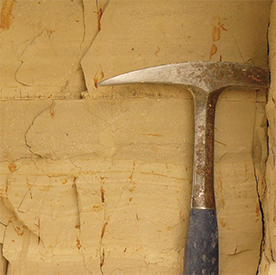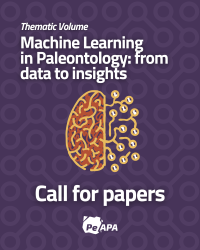STRATIGRAPHY AND DEPOSITIONAL ENVIRONMENTS OF THE SANTA CRUZ FORMATION (EARLY–MIDDLE MIOCENE) ALONG THE RÍO SANTA CRUZ, SOUTHERN PATAGONIA, ARGENTINA
DOI:
https://doi.org/10.5710/PEAPA.27.07.2019.294Keywords:
Burdigalian, Sedimentology, Fluvial system, Paleosol, Austral BasinAbstract
The Santa Cruz Formation is an Early–Middle Miocene terrestrial sedimentary succession widely distributed in southern Patagonia. Particularly, it is exposed along the southern margin of the Río Santa Cruz valley where the sedimentological and stratigraphical features are described for three localities. From east to west these localities are: Barrancas Blancas, Segundas Barrancas Blancas and Yaten Huageno. The facies analysis permits us to identify three associations, representing deposition in 1) low-energy floodplains; 2) crevasse splays and sheet floods; and 3) fluvial channels. The three localities are chronologically equivalent and represent accumulation in an aggradational low- gradient fluvial system that drained towards the east and northeast from the Patagonian Andes to the Atlantic sea. Abundant pedogenic features and some trace fossils are consistent with a temperate subhumid climate and in part, a grassland environment.
References
Ashley, G.M. and Driese, S.G. 2000. Paleopedology and paleohydrology of a volcaniclastic paleosol interval: implications for early Pleistocene stratigraphy and paleoclimate record, Olduvai Gorge, Tanzania. Journal of Sedimentary Research, 70: 1065–1080.
Bargo, M.S., Cerdeño, E., Olivero, E.B., López Cabrera, M.I., Reguero, M.A. and Vizcaíno, S.F. 2018. Primer registro de Astrapotheriidae (Mammalia, Astrapotheria) de la Formación Cullen (Mioceno temprano) de Tierra del Fuego. Reunión de Comunicaciones de la Asociación Paleontológica Argentina (Puerto Madryn), Abstract Book: 43.
Bedatou, E., Melchor, R.N., Bellosi, E. and Genise, J.F. 2008. Crayfish burrows from Late Jurassic–Late Cretaceous continental deposits of Patagonia: Argentina. Their palaeoecological, palaeoclimatic and palaeobiogeographical significance. Palaeogeography, Palaeoclimatology, Palaeoecology 257: 169–184.
Biddle, K.T., Uliana, M.A., Mitchum, R.M., Fitzgerald, M.G. and Wright, R.C. 1986. The stratigraphy and structural evolution of the central and eastern Magallanes Basin, southern South America. In: P.A. Allen, P. Homewood (Eds.), Foreland Basins, International Association of Sedimentologists, Special Publication 8: 41–61.
Bown, T.M. and Fleagle, J.G. 1993. Systematics, biostratigraphy, and dental evolution of the Palaeothentidae, later Oligocene to early–middle Miocene (Deseadan–Santacrucian) caenolestoid marsupials of South America. Journal of Paleontology 67: 1–76.
Buol, W.S., Southard, R.J., Graham, R.C. and McDanield, P.A. 2011. Soil Genesis and Classifications, Sixth edition, Wiley-Blackwell, Oxford, 543 p.
Burns, C.E., Mountney, N.P., Hodgson, D.M. and Colombera, L. 2017. Anatomy and dimensions of fluvial crevasse-splay deposits: Examples from the Cretaceous Castlegate Sandstone and Neslen Formation, Utah, USA. Sedimentary Geology 351: 21–35.
Catena, A.M., Hembree, D.I., Saylor, B.Z., Anaya, F. and Croft, D.A. 2016. Paleoenvironmental analysis of the Neotropical fossil mammal site of Cerdas, Bolivia (middle Miocene) based on ichnofossils and paleopedology. Palaeogeography, Palaeoclimatology, Palaeoecology 459: 423–439.
Cobos, J.C., Rodríguez, M.F. and Panza, J.L. 2014. Hoja Geológica 5172-II, Paso Río Bote, Provincia de Santa Cruz. Instituto de Geología y Recursos Minerales, Servicio Geológico Minero Argentino, Boletín 405: 1–99.
Cuitiño, J.I. and Scasso, R.A. 2010. Sedimentología y paleoambientes del Patagoniano y su transición a la Formación Santa Cruz al sur del Lago Argentino, Patagonia Austral. Revista de la Asociación Geológica Argentina 66: 406–417.
Cuitiño, J.I., Fernicola, J.C., Kohn, M.J., Trayler, R., Naipauer, M., Bargo, M.S., Kay, R.F. and Vizcaíno, S.F. 2016. U-Pb geochronology of the Santa Cruz Formation (early Miocene) at the Río Bote and Río Santa Cruz (southernmost Patagonia, Argentina): Implications for the correlation of fossil vertebrate localities. Journal of South American Earth Sciences 70:198–210.
Cuitiño, J.I. Vizcaíno, S.F., Bargo, M.S. and Aramendía, I. In press. Sedimentology and fossil vertebrates of the Santa Cruz Formation (early Miocene) in Lago Posadas, southwestern Patagonia, Argentina. Andean Geology.
Fernicola, J.C., Cuitiño, J.I., Vizcaíno, S.F., Bargo, M.S. and Kay, R.F. 2014. Fossil localities of the Santa Cruz Formation (Early Miocene, Patagonia, Argentina) prospected by Carlos Ameghino in 1887 revisited and the location of the Notohippidian. Journal of South American Earth Sciences 52: 94–107.
Fosdick, J.C., Grove, M., Hourigan, J.K. and Calderón, M. 2013. Retroarc deformation and exhumation near the end of the Andes, southern Patagonia. Earth and Planetary Science Letters 361: 504–517.
Frey, R.W., Curran, H.A. and Pemberton, S.G. 1984. Tracemaking activities of crabs and their environmental significance: the ichnogenus Psilonichnus. Journal of Paleontology 58: 333–350.
Fürsich, F.T. 1981. Invertebrate trace fossils from the Upper Jurassic of Portugal. Comunicações dos Serviços Geológicos de Portugal 67: 153–168.
Genise, J.F. 2017. Ichnoentomology: insect traces in soils and paleosols. Topics in Geobiology 37. Springer, 695p.
Ghiglione, M.C., Ramos, V.A. Cuitiño, J.I. and Varberón, V. 2016. Growth of the Southern Patagonian Andes (46–53°S) and Their Relation to Subduction Processes. In: A. Folguera, M. Naipauer, L. Sagripanti, M. Ghiglione, D. Orts and L. Giambiagi (Eds.), Growth of the Southern Andes. Springer Earth System Sciences, DOI 10.1007/978-3-319-23060-3_10, Springer International Publishing, Switzerland.
Hasiotis, S.T. and Mitchell, C.E. 1993. A comparison of crayfish burrows morphologies: Triassic and Holocene fossil, paleo- and neoichnological evidence and identification of their burrowing signatures. Ichnos 2: 291–314.
Kay, R.F., Vizcaíno, S.F. and Bargo, M.S. 2012. A review of the paleoenvironment and paleoecology of the Miocene Santa Cruz Formation. In: S.F. Vizcaíno, R.F. Kay and M.S. Bargo (Eds.), Early Miocene Paleobiology in Patagonia: High-Latitude Paleocommunities of the Santa Cruz Formation. Cambridge University Press, p. 331–365.
Krapovickas, V. 2012. Ichnology of distal overbank deposits of the Santa Cruz Formation (late Early Miocene): paleohydrologic and paleodimatic significance. In: S.F. Vizcaíno, R.F. Kay and M.S. Bargo (Eds.), Early Miocene Paleobiology in Patagonia: High-Latitude Paleocommunities of the Santa Cruz Formation. Cambridge University Press, p. 91–103.
Kraus, M.J. and Hasiotis, S.T. 2006. Significance of different modes of rhizolith preservation to interpreting paleoenvironmental and paleohydrologic settings: examples from Paleogene paleosols, Bighorn Basin, Wyoming, U.S.A. Journal of Sedimentary Research 76: 633–646.
Maitland, P. and Maitland, D. 1985. The Australian desert crab. Australian Natural History 21: 496–498.
Marshall, L., Hoffstetter, R. and Pascual, R. 1983. Mammals and stratigraphy: geochronology of the continental mammal-bearing Tertiary of South America. Palaeovertebrata Mémoire Extraordinaire 1984: 1–76.
Matheos, S.D. and Raigemborn, M.S. 2012. Sedimentology and paleoenvironment of the Santa Cruz formation. In: S.F. Vizcaíno, R.F. Kay and M.S. Bargo (Eds.), Early Miocene Paleobiology in Patagonia: High-Latitude Paleocommunities of the Santa Cruz Formation. Cambridge University Press, p. 59–82.
Miall, A.D. 2014. Fluvial Depositional Systems. Springer, Switzerland, 316 p.
Parras, A.M. and Cuitiño, J.I. In press. The stratigraphic and paleoenvironmental significance of the regressive Monte Observación Member, early Miocene of the Austral Basin, Patagonia. Latin American Journal of Sedimentology and Basin Analysis.
Pascual, R., Ortega Hinojosa, E.J., Gondar, D. and Tonni, E.P. 1965. Las edades del Cenozoico mamalífero de la Argentina, con especial atención a aquéllas del territorio bonaerense. Anales de la Comisión de Investigaciones Científicas de la Provincia de Buenos Aires 6: 165–193.
Pérez, L.M., Cuitiño, J.I., Varela, A.N. and Muñoz, N.A., this volume. The stratigraphic and paleoenvironmental significance of the presence of Diplodon cf. colhuehuapensis (Bivalvia – Hyriidae) in the Santa Cruz Formation (early Miocene), Argentine. Publicación Electrónica de la Asociación Paleontológica Argentina.
Perkins, M.E., Fleagle, J.G., Heizler, M.T., Nash, B,. Bown, T.M., Tauber, A.A. and Dozo, M.T. 2012. Tephrochronology of the Miocene Santa Cruz and Pinturas Formations, Argentina. In: S.F. Vizcaíno, R.F. Kay and M.S. Bargo (Eds.), Early Miocene Paleobiology in Patagonia: High-Latitude Paleocommunities of the Santa Cruz Formation. Cambridge University Press, p. 23–40.
Raigemborn, M.S., Matheos, S.D., Krapovickas, V., Vizcaíno, S.F., Bargo, M.S., Kay, R.F., Fernicola, J.C. and Zapata, L. 2015. Paleoenvironmental reconstruction of the coastal Monte León and Santa Cruz formations (Early Miocene) at Rincón del Buque, Southern Patagonia: A revisited locality. Journal of South American Earth Sciences 60:31–55.
Raigemborn, M.S., Krapovickas, V., Beilinson, E., Peral, L.E.G., Zucol, A.F., Zapata, L. and Sial, A.N. 2018. Multiproxy studies of Early Miocene pedogenic calcretes in the Santa Cruz Formation of southern Patagonia, Argentina indicate the existence of a temperate warm vegetation adapted to a fluctuating water table. Palaeogeography, Palaeoclimatology, Palaeoecology 500: 1–23.
Raigemborn, M.S., Krapovickas, V., Zucol, A.F., Zapata, L., Beilinson, E., Toledo, N., Perry, J., Lizzoli, S., Martegani, L. and Passeggi, E. In press. Paleosols and related soil-biota of the early Miocene Santa Cruz Formation (Austral-Magallanes Basin, Argentina): a multidisciplinary approach to reconstructing ancient terrestrial landscapes. Latin American Journal of Sedimentology and Basin Analysis.
Retallack, G.J. 2001. Soils of the Past. An introduction to paleopedology. 2nd edition, Blackwell Science, 404 p.
Retallack. G.J., Bestland, E.A. and Fremd, T. 2000 Eocene and Oligocene Paleosols in Central Oregon. Geological Society of America, Special Paper 344. https://doi.org/10.1130/0-8137-2344-2.1
Sachse, F.V., Strozyk, F., Anka, Z., Rodriguez, J.F. and di Primio, R. 2016. The tectono-stratigraphic evolution of the Austral Basin and adjacent areas against the background of Andean tectonics, southern Argentina, South America. Basin Research 28: 462–482, doi: 10.1111/bre.12118
Sacomani, L.E. and Panza, J.L. 2011. Hojas Geológicas 5169-I y 5169-II, Puerto Coig y Puerto Santa Cruz, Provincia de Santa Cruz. Instituto de Geología y Recursos Minerales, Servicio Geológico Minero Argentino, Boletín 392: 1–133.
Stoops, G., Marcelino, V. and Mess, F. 2010. Interpretation of Micromorphological Features of Soils and Regoliths. Elsevier, 720 p.
Tauber, A.A. 1999. Los vertebrados de la Formación Santa Cruz (Mioceno inferior-medio) en el extremo sureste de la Patagonia y su significado paleoecológico. Revista Española de Paleontología 14: 173–182.
Tauber, A.A., Palacios, M.E., Krapovickas, J. and Rodríguez, P. 2008. La Formación Santa Cruz (Mioceno temprano-medio) en la mitad occidental del Río Santa Cruz, Patagonia, Argentina. XVII Congreso Geológico Argentino, Jujuy, Actas: 1500–1501.
Tejedor, M.F., Tauber, A.A., Rosenberger, A.L., Swisher, C.C. and Palacios, M.E. 2006. New primate genus from the Miocene of Argentina. Proceedings of the National Academy of Sciences 103: 5437–5441.
Trayler, R., Schmitz, M., Cuitiño, J.I., Kohn, M., Bargo, M.S., Kay, R., Strömberg, C. and Vizcaíno S.F., submitted. An Improved Approach to Age-Modeling in Deep Time: Implications for the Santa Cruz Formation, Argentina. Geological Society of America Bulletin.
Vannini, M., Cannicci, S., Berti, R. and Innocenti, G. 2003. Cardisoma carnifex (Brachyura): where have all the babies gone? Journal of Crustacean Biology 23: 55–59.
Vizcaíno, S.F., Kay, R.F. and Bargo, M.S. 2012. Early Miocene Paleobiology in Patagonia: High-latitude Paleocommunities of the Santa Cruz Formation. Cambridge University Press, 378 p.
Vizcaíno, S.F., Bargo, M.S. and Fernicola, J.C. 2013. Expediciones paleontológicas durante los Siglos XIX y XX a la Formación Santa Cruz (Mioceno Inferior, Patagonia) y destino de los fósiles. III Congreso Argentino de Historia de la Geología, Actas: 231–246.
Vizcaíno, S.F., Bargo, M.S., Cuitiño, J.I., Pérez, M.E., Muñoz, N.A., Aramendía, I., Tomassini, R. L. and Kay, R.F. 2018. The outstanding Río Chalía (=Seuhén) outcrops of the Santa Cruz Formation (early Miocene, Burdigalian) and its fossil vertebrate content. Reunión de Comunicaciones de la Asociación Paleontológica Argentina (Puerto Madryn), Abstract Book: 104.
Zapata, L. 2018. [Estudio paleoambiental de la Formación Santa Cruz (Mioceno inferior-medio) entre los ríos Coyle y Gallegos, Patagonia Austral, Argentina. PhD Thesis, Universidad Nacional de La Plata, 304 p. Unpublished.].
Zonneveld, J.P., Lavigne, J.M., Bartels, W.S. and Gunnell, G.F. 2006. Lunulichnus tuberosus ichnogen. and ichnosp. nov. from the Early Eocene Wasatch Formation, Fossil Butte National Monument, Wyoming: an arthropod-constructed trace fossil associated with alluvial firmgrounds. Ichnos 13: 87–94.

Downloads
Published
Issue
Section
License
Copyright (c) 2019 Publicación Electrónica de la Asociación Paleontológica Argentina

This work is licensed under a Creative Commons Attribution-NoDerivatives 4.0 International License.
Authors retain copyright and grant the journal right of first publication with the work simultaneously licensed under a Atribución/Reconocimiento 4.0 Internacional that allows others to share the work with an acknowledgement of the work's authorship and initial publication in this journal.
















